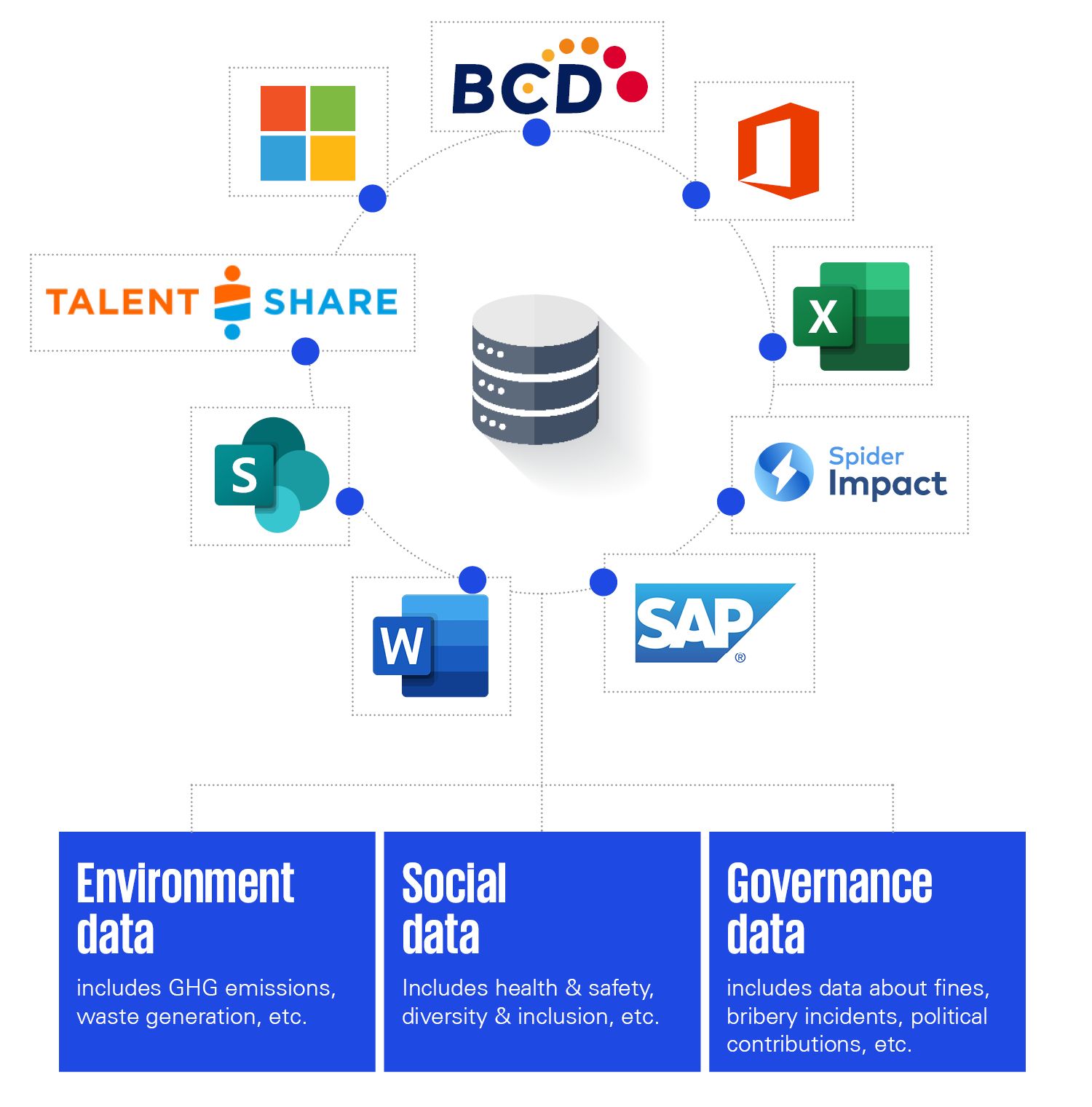The Corporate Sustainability Reporting Directive (CSRD) aims to promote transparency, accountability, and the adoption of sustainable practices within organizations. It requires organizations to provide both quantitative and qualitative disclosures that demonstrate their commitment to sustainability. The ability to collect, manage, and report Environmental, Social, and Governance (ESG) data is crucial for ensuring compliance with CSRD reporting standards. Organizations must not only disclose their ESG metrics but also guarantee the accuracy and auditability of the underlying data that is used for metric calculations.
While the Omnibus publication indicates extended timelines and exempts certain organizations from mandatory compliance with the CSRD, sustainability reporting remains essential for meeting stakeholder expectations and adhering to other regulations. Organizations must stay proactive, prioritizing sustainability reporting to inform decision-making, drive meaningful actions, and remain ahead of future requirements.
Since sustainability reporting can be executed as a standalone, well-scoped initiative, it offers organizations an opportunity to advance their data practices more quickly compared to traditional, often more complex data initiatives. By leveraging the resulting data, insights, and drivers, organizations can accelerate their journey toward becoming more data driven. Strategically integrating sustainability reporting allows organizations to refine reporting practices and strengthen their overall reporting architecture.
Data maturity challenges in the context of your CSRD reporting
Setting up sustainability reporting and data management for CSRD compliance presents unique challenges. Ensuring auditability and traceability from ESG metrics to data sources requires high-quality, trustworthy data. Businesses face three key challenges related to data maturity in their journey towards CSRD readiness.
1. Data traceability - ESG data is scattered across the organization
Organizations often struggle with scattered and unstructured data across various applications owned by different business departments or teams, which hinders their ability to meet auditability and traceability standards.
Some organizations need to report on over 150 ESG metrics, sourcing data from multiple affiliates, countries, departments, and systems. This data often varies in quality and granularity. Gaining a clear view of the data value chain—from source to report—can be complex, but documenting this flow is essential to ensure the integrity and credibility of sustainability reports.
Illustrative example: Scattered data in scope 1 GHG emissions
Reporting on Scope 1 GHG emissions requires organizations to effectively track, integrate, consolidate, and manage energy consumption data from the buildings and vehicles under their control. Without a centralized data management approach, disparate data sources can lead to inefficiencies, inaccuracies, and challenges in validating emissions data.

2. Data culture & literacy - Audit-proof sustainability reporting requires a shift in culture & mindset
Establishing robust processes for sustainability reporting goes beyond just understanding how data flows through the organization, it also requires engaging employees in effective data management and ensuring data quality.
Currently, many organizations face challenges in fostering a data culture, as employees may not see the direct business value in data management efforts. This lack of engagement results in a limited understanding of data practices, ESG metrics, and sustainability concepts across the organization.
To address this, organizations can leverage the CSRD as a case for change to enhance data literacy. By emphasizing the importance of accurate and efficient data delivery for sustainability reporting, employees can be motivated to adopt a common language for ESG metrics, understand data delivery protocols, and grasp how to consolidate data to calculate ESG metrics effectively.
Illustrative example: Different definitions of business concepts and metrics
Reporting on the number of employees requires a clear and standardized definition of the term “employee” to ensure consistency and precision. All departments and affiliates must adopt the same calculation methodology. For example, some affiliates may include students in their employee headcount, while others may exclude them. Aligning these approaches is essential to provide a reliable and unified view across the organization.
3. Data governance - Lack of clear governance across the ESG data value chain
Auditability of sustainability reporting not only requires the set-up of clear data collection and reporting processes , but also the implementation of clear ownership and responsibilities across the ESG data value chain. Clear roles and processes are critical for successful sustainability reporting. They must answer the question: ‘who will do what in which way with regards to ESG data collection and reporting?’. The nature of data ownership, metric ownership, and report ownership is different for every organization, especially when different entities and departments are involved.
Illustrative example: Lack of ownership for cross-functional data
When ESG data originates from various business domains such as HR, facilities, and production, the absence of clear governance complicates effective management and consolidation of ESG data for accurate reporting. Establishing clear governance structures, roles, and processes is essential for ensuring effective data management.
Get started on your sustainability reporting readiness journey
Start with a data gap analysis
To evaluate how well your organization is prepared to report on (mandatory) ESG metrics, it is vital to map out the entire ESG data value chain, transforming raw data into actionable insights. In the lead-up to the new reporting requirements, it’s crucial not only to identify and address data gaps but also to strengthen data integrity.
Key questions of the assessment include:
- Which ESG metrics are you already reporting on today?
- Is there a shared understanding of the calculation method and underlying data sources?
- In which systems does the underlying (ESG) data reside?
- Are these systems at group or affiliate level?
- Who is responsible for the (ESG) data?
- How qualitative is the (ESG) data?
The outcome of this evaluation provides a comprehensive overview of your organization’s IT landscape, highlighting the data sources for required ESG data. Additionally, preparing for the data gap analysis and identifying key individuals for consultation is instrumental in pinpointing relevant stakeholders. This process not only clarifies roles and responsibilities but also raises awareness among stakeholders about the importance of sustainability reporting.
This assessment forms the starting point for designing the Sustainability Reporting Target Operating Model, providing a foundation for streamlining data management and reporting processes.
As part of KPMG's holistic support, we offer the KPMG CSRD Data Readiness Survey to assist organizations at scale and streamline the questioning process, with results presented in interactive dashboards.
Design a future-proof Sustainability Reporting Target Operating Model (TOM)
The data gap analysis serves as a catalyst for organizational transformation. Based on its outcome, organizations can design a data governance framework and a technology blueprint, laying the foundation for informed prioritization and decision-making. This process enhances data stewardship, strategic foresight, and transparency, ultimately driving more effective sustainability reporting and performance.
KPMG Powered Sustainability helps to provide a model answer to the workflows, technologies, and governance that are required to transform your organization’s ability to meet the sustainability reporting needs of today, while providing a platform to intercept future sustainability reporting needs.
How can you build further on this journey?
Becoming CSRD compliant can be a powerful catalyst for establishing effective and efficient sustainability reporting. But why stop there? Use this momentum to foster a data-driven culture that enhances not only your reporting but your entire approach to data and decision-making.
By aligning sustainability reporting requirements with operational needs, organizations unlock a unique opportunity to enhance both their sustainability and overall reporting infrastructure. Automating reporting processes not only enhances the efficiency and quality of sustainability reporting but also strengthens strategic and operational reporting.
Take a moment to reflect on your organization today. What is the current data maturity? Which investments in data capabilities are being made? What are the strategic initiatives driving these investments, and are there any synergies?
Reach out to our dedicated teams for further information:
Authors: Narjis Berrazi, Junior Advisor & Michelle Claessens, Advisor & Hanne Gielen, Advisor
Explore
Connect with us
- Find office locations kpmg.findOfficeLocations
- kpmg.emailUs
- Social media @ KPMG kpmg.socialMedia







